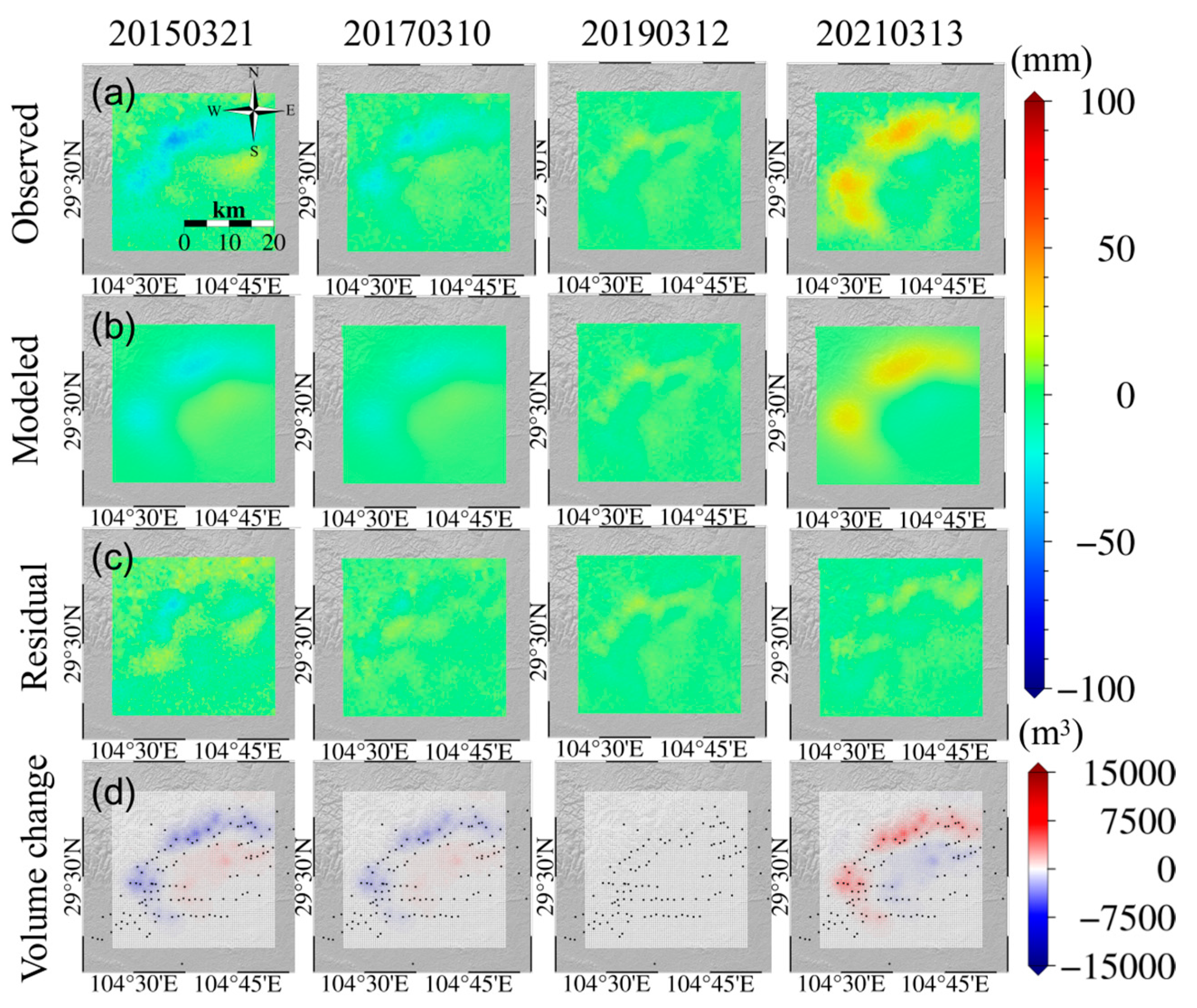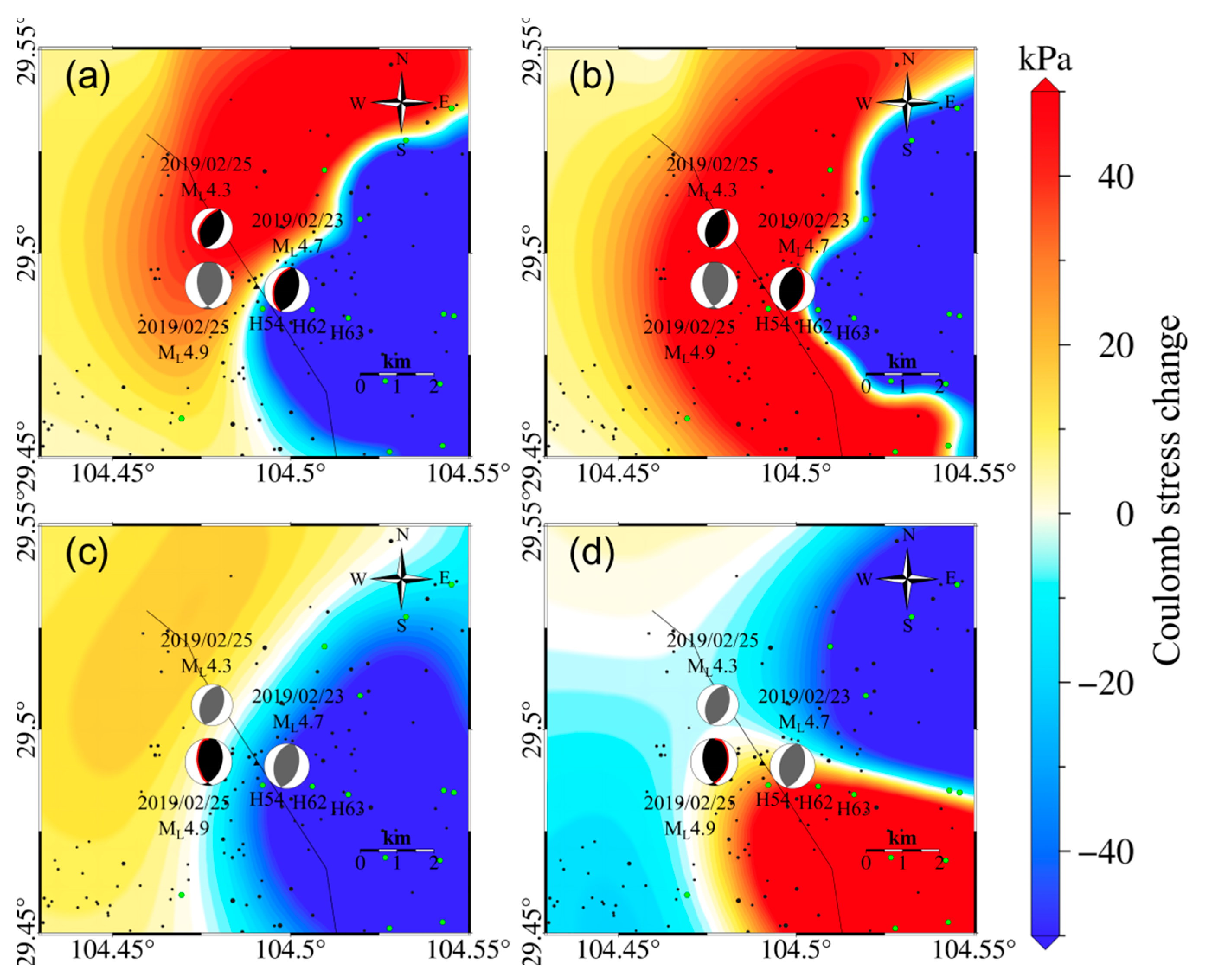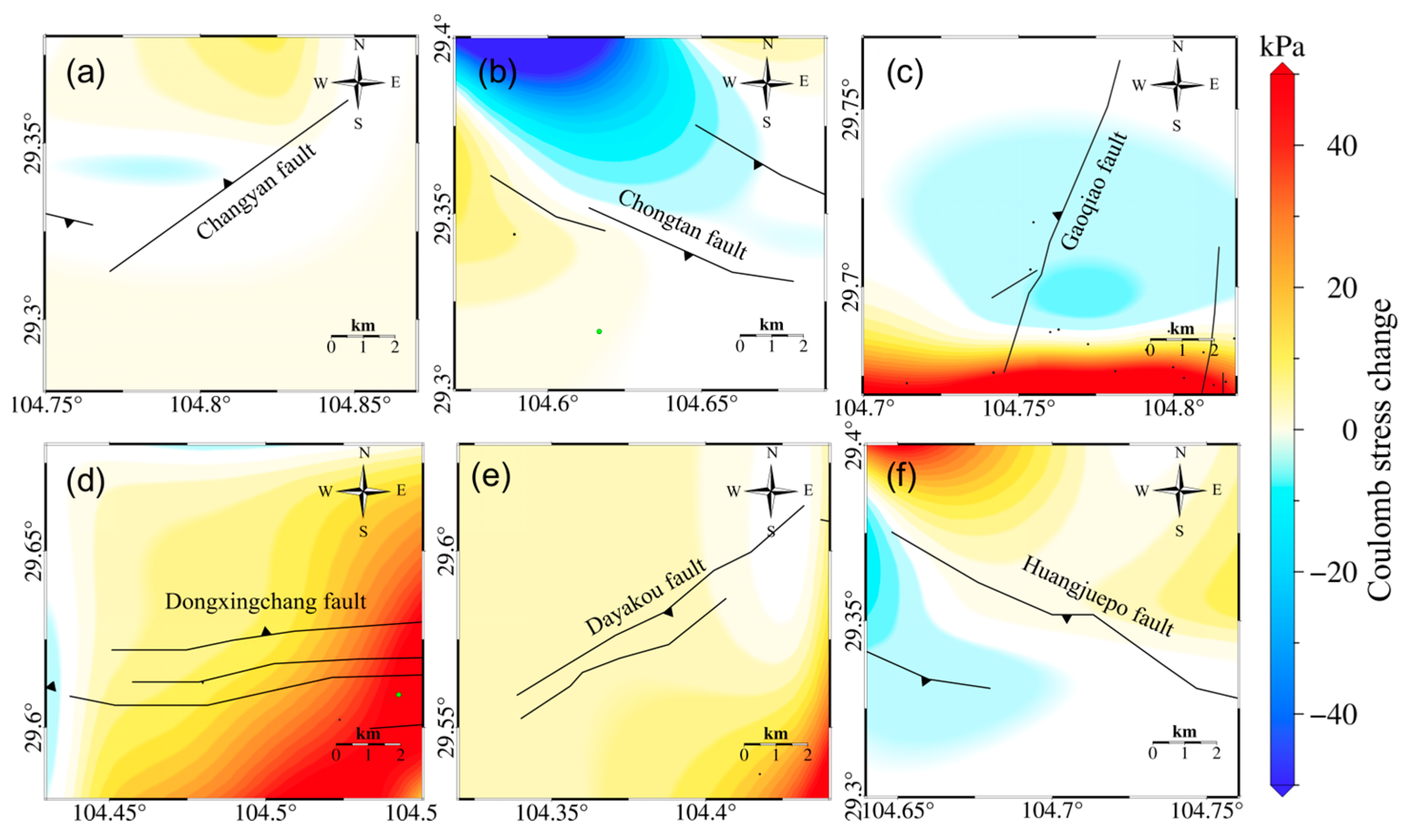InSAR- and PCA-Based Inversion Reveals the Surface Deformation and Earthquake Sequence in the Weiyuan-Rongxian Shale Gas Field
Abstract
:1. Introduction
2. Study Area
3. Methods
3.1. InSAR Processing
3.2. Joint MT-InSAR and the PCA-Based Inversion Method
3.3. Coulomb Stress of Faults
4. Result
4.1. InSAR Deformation
4.2. Volume Changes
4.3. Coulomb Stress Estimation
5. Discussion
5.1. Relationship between the Rongxian ML4.9 Earthquake and Hydraulic Fracturing
5.2. Relationship between the Weiyuan ML5.4 and Zizhong ML5.2 Earthquakes and Hydraulic Fracturing
5.3. Analysis of Regional Seismic Hazards
6. Conclusions
Author Contributions
Funding
Data Availability Statement
Acknowledgments
Conflicts of Interest
References
- Rafiee, M.; Soliman, M.Y.; Pirayesh, E. Hydraulic Fracturing Design and Optimization: A Modification to Zipper Frac. In Proceedings of the SPE Annual Technical Conference and Exhibition, San Antonio, TX, USA, 8–10 October 2012; p. SPE–159786-MS. [Google Scholar] [CrossRef]
- Osiptsov, A.A. Fluid Mechanics of Hydraulic Fracturing: A Review. J. Pet. Sci. Eng. 2017, 156, 513–535. [Google Scholar] [CrossRef]
- Raleigh, C.B.; Healy, J.H.; Bredehoeft, J.D. An Experiment in Earthquake Control at Rangely, Colorado. Science 1976, 191, 1230–1237. [Google Scholar] [CrossRef] [PubMed]
- Rozhko, A.Y. Role of Seepage Forces on Seismicity Triggering. J. Geophys. Res. Solid Earth 2010, 115, B11314. [Google Scholar] [CrossRef]
- Foulger, G.R.; Wilson, M.P.; Gluyas, J.G.; Julian, B.R.; Davies, R.J.-P. Global Review of Human-induced Earthquakes. Earth-Sci. Rev. 2017, 178, 438–514. [Google Scholar] [CrossRef]
- Schultz, R.; Skoumal, R.J.; Brudzinski, M.R.; Eaton, D.; Baptie, B.; Ellsworth, W. Hydraulic Fracturing-Induced Seismicity. Rev. Geophys. 2020, 58, e2019RG000695. [Google Scholar] [CrossRef]
- Zhang, J.; Kuang, W.H.; Zhang, X.; Mo, C.K.; Zhang, D.X. Global Review of Induced Earthquakes in Oil and Gas Production Fields. Rev. Geophys. Planet. Phys. 2021, 52, 239–265. [Google Scholar] [CrossRef]
- Lei, X.; Su, J.; Wang, Z. Growing Seismicity in the Sichuan Basin and Its Association with Industrial Activities. Sci. China Earth Sci. 2020, 63, 1633–1660. [Google Scholar] [CrossRef]
- Yang, H.; Zhou, P.; Fang, N.; Zhu, G.; Xu, W.; Su, J.; Meng, F.; Chu, R. A Shallow Shock: The 25 February 2019 ML 4.9 Earthquake in the Weiyuan Shale Gas Field in Sichuan, China. Seismol. Res. Lett. 2020, 91, 3182–3194. [Google Scholar] [CrossRef]
- Chen, H.; Meng, X.; Niu, F.; Tang, Y.; Yin, C.; Wu, F. Microseismic Monitoring of Stimulating Shale Gas Reservoir in SW China: 2. Spatial Clustering Controlled by the Preexisting Faults and Fractures. J. Geophys. Res. Solid Earth 2018, 123, 1659–1672. [Google Scholar] [CrossRef]
- Yi, G.X.; Long, F.; Liang, M.J.; Zhao, M.; Wang, S.W. Geometry and Tectonic Deformation of Seismogenic Structures in the Rongxian-Weiyuan-Zizhong Region, Sichuan Basin: Insight from Focal Mechanism Solutions. Chin. J. Geophys. 2020, 63, 3275–3291. [Google Scholar] [CrossRef]
- Sheng, M.; Chu, R.; Ni, S.; Wang, Y.; Jiang, L.; Yang, H. Source Parameters of Three Moderate Size Earthquakes in Weiyuan, China, and Their Relations to Shale Gas Hydraulic Fracturing. J. Geophys. Res. Solid Earth 2020, 125, e2020JB019932. [Google Scholar] [CrossRef]
- Wang, M.; Yang, H.; Fang, L.; Han, L.; Jia, D.; Jiang, D.; Yan, B. Shallow Faults Reactivated by Hydraulic Fracturing: The 2019 Weiyuan Earthquake Sequences in Sichuan, China. Seismol. Res. Lett. 2020, 91, 3171–3181. [Google Scholar] [CrossRef]
- Liu, H.; Xie, L.; Zhao, G.; Ali, E.; Xu, W. A Joint InSAR-GNSS Workflow for Correction and Selection of Interferograms to Estimate High-resolution Interseismic Deformations. Satell. Navig. 2023, 4, 14. [Google Scholar] [CrossRef]
- Bao, Y.X.; Sun, J.B.; Li, T.; Liang, C.R.; Zhan, Y.; Han, J.; Li, Y.S.; Zhang, J.F. Characteristics of Surface Deformation Field of Changning Shale Gas Block in Southern Sichuan Basin with InSAR Data. Acta Seismol. Sin. 2022, 44, 427–451. [Google Scholar] [CrossRef]
- Li, B.Q.; Khoshmanesh, M.; Avouac, J.-P. Surface Deformation and Seismicity Induced by Poroelastic Stress at the Raft River Geothermal Field, Idaho, USA. Geophys. Res. Lett. 2021, 48, e2021GL095108. [Google Scholar] [CrossRef]
- Shirzaei, M.; Ellsworth, W.L.; Tiampo, K.F.; González, P.J.; Manga, M. Surface Uplift and Time-dependent Seismic Hazard Due to Fluid Injection in Eastern Texas. Science 2016, 353, 1416–1419. [Google Scholar] [CrossRef] [PubMed]
- Vasco, D.W.; Johnson, L.R.; Goldstein, N.E. Using Surface Displacement and Strain Observations to Determine Deformation at Depth, with an Application to Long Valley Caldera, California. J. Geophys. Res. 1988, 93, 3232–3242. [Google Scholar] [CrossRef]
- Tamburini-Beliveau, G.; Grosso-Heredia, J.A.; Béjar-Pizarro, M.; Pérez-López, R.; Portela, J.; Cismondi-Duarte, M.; Monserrat, O. Assessment of Ground Deformation and Seismicity in Two Areas of Intense Hydrocarbon Production in the Argentinian Patagonia. Sci. Rep. 2022, 12, 19198. [Google Scholar] [CrossRef]
- Staniewicz, S.; Chen, J.; Lee, H.; Olson, J.; Savvaidis, A.; Reedy, R.; Breton, C.; Rathje, E.; Hennings, P. InSAR Reveals Complex Surface Deformation Patterns Over an 80,000 km2 Oil-Producing Region in the Permian Basin. Geophys. Res. Lett. 2020, 47, e2020GL090151. [Google Scholar] [CrossRef]
- Feng, Z.; Dong, D.; Tian, J.; Qiu, Z.; Wu, W.; Zhang, C. Geochemical Characteristics of Longmaxi Formation Shale Gas in the Weiyuan Area, Sichuan Basin, China. J. Pet. Sci. Eng. 2018, 167, 538–548. [Google Scholar] [CrossRef]
- Ma, X.H.; Zhang, X.W.; Xiong, W.; Liu, Y.Y.; Gao, J.L.; Yu, R.Z.; Sun, Y.P.; Wu, J.; Kang, L.X.; Zhao, S.P. Prospects and Challenges of Shale Gas Development in China. Pet. Sci. Bull. 2023, 8, 491–501. [Google Scholar] [CrossRef]
- Zheng, G.; Wang, H.; Wright, T.J.; Lou, Y.; Zhang, R.; Zhang, W.; Shi, C.; Huang, J.; Wei, N. Crustal Deformation in the India-Eurasia Collision Zone From 25 Years of GPS Measurements. J. Geophys. Res. Solid Earth 2017, 122, 9290–9312. [Google Scholar] [CrossRef]
- Wei, Z.; Chu, R.; Xie, J.; Bao, F.; Zeng, S.; Sheng, M.; Zeng, Q. Crustal Structure in the Weiyuan Shale Gas Field, China, and Its Tectonic Implications. Tectonophysics 2022, 837, 229449. [Google Scholar] [CrossRef]
- Ran, Q.H.; Zhao, H. Key Technology and Development Direction of Horizontal Well Drilling Weiyuan Shale Gas. Drill. Prod. Technol. 2020, 43, 12–15+16. [Google Scholar]
- Vasco, D.W.; Dixon, T.H.; Ferretti, A.; Samsonov, S.V. Monitoring the Fate of Injected CO2 Using Geodetic Techniques. Geophysics 2020, 39, 29–37. [Google Scholar] [CrossRef]
- Hooper, A.; Segall, P.; Zebker, H. Persistent Scatterer Interferometric Synthetic Aperture Radar for Crustal Deformation Analysis, with Application to Volcán Alcedo, Galápagos. J. Geophys. Res. 2007, 112, B07407. [Google Scholar] [CrossRef]
- Tizzani, P.; Berardino, P.; Casu, F.; Casu, F.; Euillades, P.A.; Euillades, P.A.; Manzo, M.; Ricciardi, G.P.; Zeni, G.; Lanari, R. Surface Deformation of Long Valley Caldera and Mono Basin, California, Investigated with the SBAS-InSAR Approach. Remote Sens. Environ. 2007, 108, 277–289. [Google Scholar] [CrossRef]
- Liu, X.; Hu, J.; Sun, Q.; Li, Z.; Zhu, J. Deriving 3-D Time-Series Ground Deformations Induced by Underground Fluid Flows with InSAR: Case Study of Sebei Gas Fields, China. Remote Sens. 2017, 9, 1129. [Google Scholar] [CrossRef]
- Hu, J.; Wang, Q.; Li, Z.w.; Zhao, R.; Sun, Q. Investigating the Ground Deformation and Source Model of the Yangbajing Geothermal Field in Tibet, China with the WLS InSAR Technique. Remote Sens. 2016, 8, 191. [Google Scholar] [CrossRef]
- Hyvärinen, A. Fast and Robust Fixed-point Algorithms for Independent Component Analysis. IEEE Trans. Neural Netw. 1999, 10, 626–634. [Google Scholar] [CrossRef]
- Kositsky, A.P.; Avouac, J.P. Inverting Geodetic Time Series with a Principal Component Analysis-based Inversion Method. J. Geophys. Res. 2010, 115, B03401. [Google Scholar] [CrossRef]
- Rucci, A.; Vasco, D.W.; Novali, F. Monitoring the Geologic Storage of Carbon Dioxide Using Multicomponent SAR Interferometry. Geophys. J. Int. 2011, 193, 197–208. [Google Scholar] [CrossRef]
- Sabah, M.; Ameri, M.; Hofmann, H.; Ebrahimi, M.I. Numerical Modeling of Injection-Induced Earthquakes Based on Fully Coupled Thermo-Poroelastic Boundary Element Method. Geothermics 2022, 105, 102481. [Google Scholar] [CrossRef]
- Varejão, F.G.; Warren, L.V.; Simões, M.G.; Cerri, R.I.; Alessandretti, L.; Santos, M.G.M.; Assine, M.L. Evaluation of Distinct Soft-sediment Deformation Triggers in Mixed Carbonate-siliciclastic Systems: Lessons from the Brazilian Pre-Salt Analogue Crato Formation (Araripe Basin, NE Brazil). Mar. Pet. Geol. 2022, 140, 105673. [Google Scholar] [CrossRef]
- Mogi, K. Relations Between the Eruptions of Various Volcanoes and the Deformations of the Ground Surfaces around them. Earthq. Res. Inst. 1958, 36, 99–134. [Google Scholar]
- Trugman, D.T.; Borsa, A.A.; Sandwell, D.T. Did Stresses from the Cerro Prieto Geothermal Field Influence the El Mayor-Cucapah Rupture Sequence? Geophys. Res. Lett. 2014, 41, 8767–8774. [Google Scholar] [CrossRef]
- Xu, W.; Gao, H.; Bürgmann, R.; Feng, G.; Li, Z.; Jiang, G. Anthropogenic Activity at the Leyte Geothermal Field Promoted the 2017 Mw 6.5 Earthquake. Tectonophysics 2022, 824, 229227. [Google Scholar] [CrossRef]
- Steketee, J.A. On Volterra’s Dislocations in a Semi-infinite Elastic Medium. Can. J. Phys. 1958, 36, 192–205. [Google Scholar] [CrossRef]
- Yong, R.; Chen, G.S.; Yang, X.F.; Huang, S.; Li, B.; Zheng, M.J.; Liu, W.P.; He, Y.P. Profitable Development Technology of the Changning-Weiyuan National Shale Gas Demonstration Area in the Sichuan Basin and Its Enlightenment. Nat. Gas Ind. 2022, 42, 136–147. [Google Scholar] [CrossRef]
- Zhang, Q.; Li, X.; Li, S.K.; Yang, J.J.; Zhou, J.H. Evaluation of Water Environmental Carrying Capacity in Weiyuan County Based on Shale Gas Development. Sci. Technol. Eng. 2021, 21, 9152–9159. [Google Scholar]
- Lin, Y.-n.N.; Kositsky, A.P.; Avouac, J.-P. PCAIM Joint Inversion of InSAR and Ground-based Geodetic Time Series: Application to Monitoring Magmatic Inflation Beneath the Long Valley Caldera. Geophys. Res. Lett. 2010, 37, L23301. [Google Scholar] [CrossRef]
- Wu, X.; Xia, J.; Guan, B.; Yan, X.; Zou, L.; Liu, P.; Yang, L.; Hong, S.; Hu, S. Water Availability Assessment of Shale Gas Production in the Weiyuan Play, China. Sustainability 2019, 11, 940. [Google Scholar] [CrossRef]









Disclaimer/Publisher’s Note: The statements, opinions and data contained in all publications are solely those of the individual author(s) and contributor(s) and not of MDPI and/or the editor(s). MDPI and/or the editor(s) disclaim responsibility for any injury to people or property resulting from any ideas, methods, instructions or products referred to in the content. |
© 2024 by the authors. Licensee MDPI, Basel, Switzerland. This article is an open access article distributed under the terms and conditions of the Creative Commons Attribution (CC BY) license (https://creativecommons.org/licenses/by/4.0/).
Share and Cite
Huo, H.; Xu, W.; Xie, L.; Jiang, K.; Jiang, Y. InSAR- and PCA-Based Inversion Reveals the Surface Deformation and Earthquake Sequence in the Weiyuan-Rongxian Shale Gas Field. Remote Sens. 2024, 16, 1929. https://doi.org/10.3390/rs16111929
Huo H, Xu W, Xie L, Jiang K, Jiang Y. InSAR- and PCA-Based Inversion Reveals the Surface Deformation and Earthquake Sequence in the Weiyuan-Rongxian Shale Gas Field. Remote Sensing. 2024; 16(11):1929. https://doi.org/10.3390/rs16111929
Chicago/Turabian StyleHuo, Hongyu, Wenbin Xu, Lei Xie, Kun Jiang, and Yan Jiang. 2024. "InSAR- and PCA-Based Inversion Reveals the Surface Deformation and Earthquake Sequence in the Weiyuan-Rongxian Shale Gas Field" Remote Sensing 16, no. 11: 1929. https://doi.org/10.3390/rs16111929






